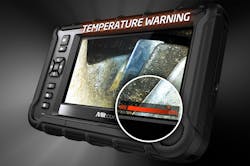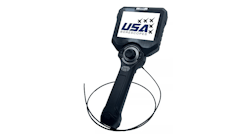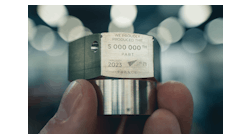A Look Inside the 2000J Series
USA Borescopes’ USA 2000J Series Videoscope allows technicians to inspect aircraft parts without tearing them apart. The videoscope comes in two-, three-, five- and seven-meter lengths, though the two- and three-meter lengths are the most popular for the aviation industry.
Bill French, sales representative for USA Borescopes, said it’s important to use the correct borescope length, depending on what an aircraft maintenance employee is inspecting.
“It’s kind of a funny thing,” French said. “What a lot of people would think is ‘well hey, just get the longest one because you can do everything with the longest one.’ Well, the problem with that is if you buy a 20-foot borescope and you really only need a six-footer, every time you use that, you’re tripping over 14 feet of probe that you don’t need.”
“In aviation, most of your gearbox inspection folks prefer the two-meter and then depending on the engine size, some of the commercial jet airliners require the three-meter,” French continued. He also noted aircraft maintenance professionals working in the PowerGen industry will utilize longer probes.
Customers can choose to buy an interchangeable probe borescope, which allows them to rotate between the two-, three-, five- and seven-meter lengths, French said. This means operators can do inspections on different types of equipment without worrying about the borescope being too short or too long.
“Maybe they have inspections that require a two-meter, but they also have inspections that require a seven-meter. They can buy both probes and just use that one control station,” French said. “The system will also support a 3.9-millimeter probe.”
The USA 2000J Series has an optimized optic system and an HD CMOS sensor, which French said can now compete with more expensive CCD image sensors. “In the past, there was a huge difference between the CCD image sensors and the lower-cost CMOS image sensors,” French noted. “But through advanced technologies and design of the camera chips, the CMOS image sensors have closed the gap between the two.”
CCD image sensors still have better image quality than the CMOS options but French said CMOS image sensors are much cheaper. “I don’t want to mention any competitors that offer the CCD in a negative way because they make a fantastic scope. They’re just expensive and some of those systems are in excess of $50,000,” French said. “And yeah, it’s a fantastic image, but many of our customer base – our target audience – can't swing a $50,000 system.”
“The feedback we get the most is positive comments on the image quality compared with more expensive items,” French continued. “The articulation is very responsive. For guys using this on a daily basis, that’s what’s most important.”
The USA 2000J Series’ joystick articulation allows the operator to steer or control the tip of the probe to look around the inspection area. Other borescopes on the market have two toggles to go up/down and left/right. French said the joystick articulation allows for full 360 degrees of articulation. “Some things are designed specifically for right-handed people. Whether it’s a left-handed or right-handed person, you control or steer/manipulate with a thumb joystick that allows you to move the probe 360 degrees,” French said.
The USA 2000J Series also comes standard with a side-view tip so the operator can look specifically at the sides of an inspection area. “If they were going into a tube and they wanted to look at a side wall, they would put the interchangeable side-view tip on and as they’re going down the tube, they’re now looking at the side wall. They can inspect for welds or look into adjacent pipes or bores that are coming in there. It comes in really handy when there’s not enough room to articulate the probe,” French said.
The borescope is manufactured with tungsten sheathing, which French said is more durable than other stainless steel options. “Most all your borescopes are available as a tungsten or stainless steel sheathing,” French explained. “The tungsten offers a higher tensile strength and it’s a stronger metal than the stainless steel. So it is more durable and will last longer than stainless steel.”
French said what sets the USA 2000J series apart from other borescopes on the market are the features that come standard with the system. “What makes this one different in our opinion is we sell these as a complete kit. So it comes standard with the side view tip, a heavy duty case, other accessories such as a neck strap, rigidized sleeve set, kind of like a straight guide tube, and it does offer a very nice large seven-inch touchscreen. Some of the systems [on the market] are offering a smaller three- or five-inch screen, but this has a seven-inch touchscreen.”
According to French, aircraft maintenance professionals must be careful with the borescope to avoid costly repairs. They must be careful not to overexpose the borescope to heat, which is why the USA 2000J Series comes with a temperature warning. “The most expensive part on any borescope is that first couple inches at the tip. That’s where the micro-camera processor is installed and one of the things that can damage that camera is overexposure to high temperature. This system, at 100 degrees Celsius and 212 degrees Fahrenheit, will tell the operator to remove the probe from the inspection area because it’s too hot.”
French said the borescope is not necessarily delicate, but aircraft maintenance professionals must treat it with care to avoid additional repair costs. “The biggest thing is this is a system that needs to be treated with care. Of all the tools that a maintenance guy has, this is not to be used as a deburring tool if you’re going to clean something out and ram it back and forth. You treat it with care and you keep it clean.”
French noted there is no calibration required for the borescope as it does not take measurements. USA Borescopes does provide tutorial videos to teach operators how to use the system. The borescope is also programmed to work in seven different languages.





